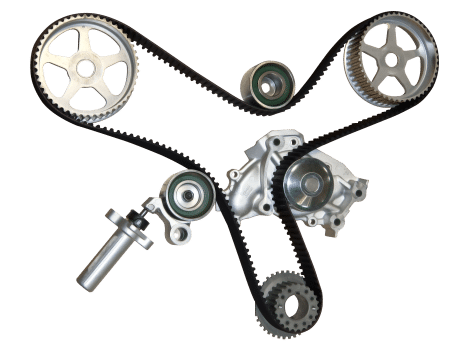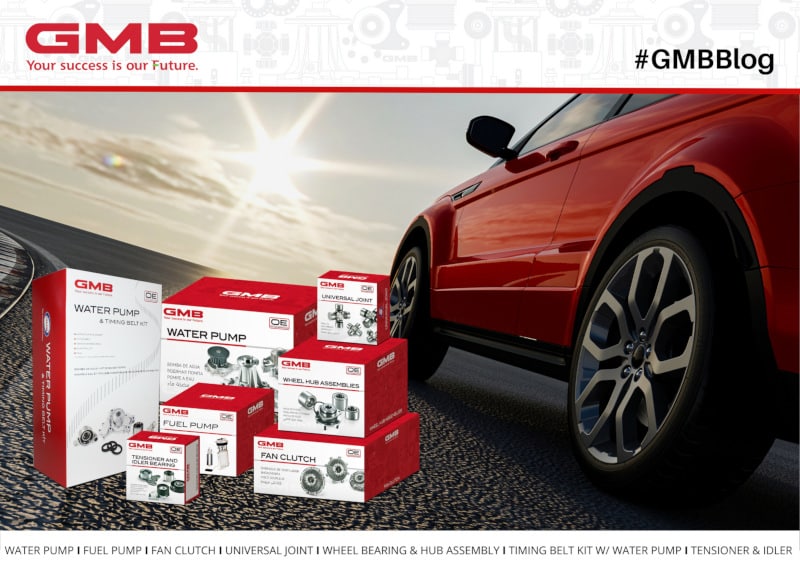Why It Is Critical To Replace Your Timing Belt Kit Before It Fails
Under normal circumstances, timing belts last between 60K and 100K miles. It’s important to service timing belts and related parts before failure happens. If your timing belt breaks while driving, you’ll run into a variety of engine issues. In this post, we’ll cover the most common issues that may happen when a timing belt snaps in a running engine.
First, let’s talk about the important role of timing belts.
Why The Timing Belt Plays An Important Role In The Engine

The timing belt ensures that the crankshaft and camshaft operate in sync with each other. The crankshaft is turned by the pistons as they raise and lower. The camshaft opens and closes the valves. When these two parts work in sync with each other, the valves are perfectly in time with the pistons. This is important for two reasons:
- When the timing is precise, the engine operates and produces power as it should.
- When the crankshaft and the camshaft operate in sync with each other, the valves and pistons won’t collide. (This only applies to modern interference engines.)
What Happens When a Timing Belt Breaks?
To put it quite plainly, your engine will stop working. If you have an interference engine, you’ll also likely see some significant engine damage, such as:
- Bent or broken valves
- Cylinder head damage
- Camshaft damage
- Cylinder wall damage
- Piston damage
It’s possible for timing belt failure to lead to thousands of dollars in engine repairs. This type of engine damage occurs because when your timing belt breaks while the engine is operating, the camshaft stops turning. Yet, the crankshaft will keep turning due to inertia. As a result, the pistons will still rise in the cylinder and crash into the valves.
But what will happen if the timing belt breaks in a non-interference engine? A non-interference engine won’t suffer any damage, but it will stop running. This is because in a non-interference engine, the pistons won’t collide with open valves.
You may be wondering why don’t all engines have a non-interference design? The answer is that interference engines allow for higher compression ratios. This in turn allows the engine to create more power, and be more fuel efficient. Almost all modern engines have an interference design.
What To Do If Your Timing Belt Breaks On The Road

Often times, timing belts break without warning. Once it happens, the engine immediately has problems. Your engine will stop running right after the timing belt snaps while driving. With an interference engine, extensive damage can occur right away. The only thing you can do is try to coast to a safe spot and call a tow truck.
There will be no way to start up the engine again unless you install a new timing belt (and fix any engine damage that has occurred).
It helps to look out for the most common signs that a timing belt is going bad:
- Timing belt noises such as squeaking
- Rough idling or misfiring
- Loss of engine power
However, most often there won’t be any symptoms. The timing belt will simply break one day. That’s why it’s very important to replace them on schedule.
This Is Why Timing Belt Systems Need To Be Serviced Or Restored On A Regular Basis
Are you looking for more information about maintaining the timing belt system? Check out this webinar (insert link here) by GMB, Import Car, and Underhood Service. You’ll gain useful nuggets of knowledge about:
- What is required to restore a timing belt system for the next 100K+ miles
- All the other parts that need to be serviced at the same time as the timing belt
- Finding quality timing belt parts and kits
- More
MORE CONTENT
Stay current!
Sign up here to get the latest news
and updates on all things GMB.
Sign Up To Receive GMB News & Updates!

